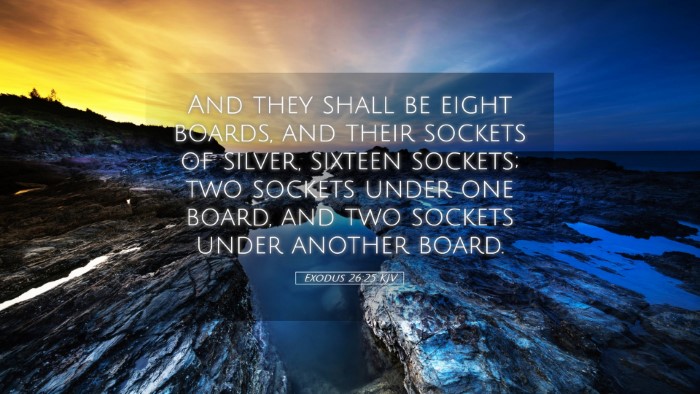Commentary on Exodus 26:25
Exodus 26:25 (KJV): "And the boards for the tabernacle he made, twenty boards for the south side southward:"
Introduction
The passage in Exodus 26:25 is part of the detailed description of the construction of the Tabernacle, which played a crucial role in the life of the Israelite community as they wandered in the wilderness. The Tabernacle served as a dwelling place for God among His people and a center for worship. This commentary seeks to provide insights into the significance of the design, materials, and spiritual implications of the Tabernacle as gleaned from various public domain commentaries.
Overview of the Tabernacle
The Tabernacle was a portable sanctuary that embodied God’s presence with His people. Each component of its structure was laden with theological symbols that underscored the holiness and majesty of God. The intricate instructions given to Moses on Mount Sinai reveal the deep spiritual realities and the importance of divine order in worship.
The Significance of the Boards
The mention of the boards in Exodus 26:25 is significant as it pertains to the structural integrity and visual representation of the Tabernacle. Each board was made from acacia wood, a material known for its durability and resistance to decay, symbolizing the enduring nature of God’s covenant and presence.
- Materials Used: Acacia wood was a choice material that speaks to God's selection of the best for His dwelling. According to Albert Barnes, the use of this wood may symbolize the incorruptibility of God’s purpose and promises.
- Design and Arrangement: The twenty boards on the south side provided a sense of symmetry and strength to the structure. Matthew Henry notes that the number twenty may represent the completeness of divine order, emphasizing God’s control over the arrangement of the sanctuary.
The Spiritual Implications
Each aspect of the Tabernacle points towards deeper spiritual truths. The physical structure served as a shadow of the heavenly reality. The boards, standing firmly and aligning in a specific manner, can be seen to represent the unity and diversity of the body of Christ.
- Unity in Diversity: Just as the boards were numerous but served together to build the Tabernacle, the believers in Christ, although different in gifts and callings, come together to form one body. Adam Clarke emphasizes that the assembly of the boards signifies the importance of community in worship.
- God’s Presence Among His People: The structure, with its carefully arranged boards, reflects the sanctity of God’s dwelling place. The assembly of the boards declared the solemnity and accessibility of God; He walks among His people. This is summed up by Matthew Henry, who expounds on the importance of recognizing God’s presence as integral to worship.
Lessons for Believers
Exodus 26:25, while a historical account, serves as a profound source of lessons for modern believers:
- Holiness in Worship: The meticulous attention to detail in the Tabernacle’s design instills a sacred respect for how God is approached in worship. Albert Barnes encourages Christians to honor the holiness of God in their worship practices.
- Community and Collaboration: The symmetry of the boards reminds us of our roles within the church. As each board plays a part in supporting the Tabernacle, so must each believer contribute to the strength and functionality of the church community.
- Reflecting God’s Nature: The durability of the materials used signifies that believers are called to embody the nature of God—strength, resilience, and beauty. Adam Clarke points out that every believer is called to reflect these qualities in their daily lives.
Conclusion
Exodus 26:25 serves not merely as a historical detail of the Israelites' worship site but encapsulates profound spiritual truths relevant to believers today. The Tabernacle, with its meticulously arranged boards, embodies God’s presence, calling His people to worship with reverence, unity, and purpose. Thus, as pastors, students, theologians, and scholars delve into these passages, they are reminded of the beauty of God's design both in the Tabernacle and in the church—a call to be a living testament to God’s enduring presence among His people.


